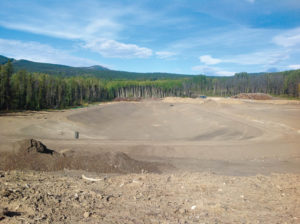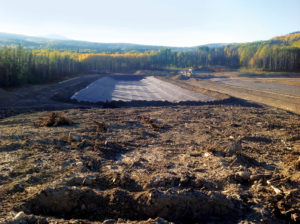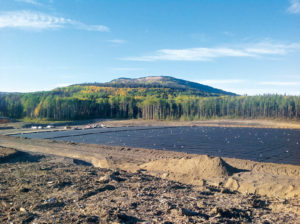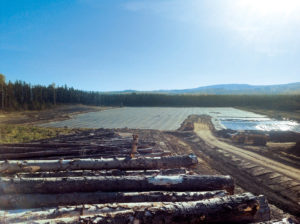

And with weather only Bigfoot could love.
Introduction
Northeastern British Columbia could, by most definitions, be considered the middle of nowhere.
Tumbler Ridge (pop. 2,710), a district municipality in the foothills of the Canadian Rockies bordering Alberta, is and was from its inception in 1981 all about coal. And like many a town with a single major industry, it waxes and wanes on the strength of that industry.
With Prince George (pop. 71,273) the nearest city of significant population at about 90mi (145km) away, as the crow flies, and the Pacific Coast some 340mi (550km) west, you could say the vast majority of the northern tier of British Columbia (BC) has more trees, mountain peaks, and wildlife than humans.
The project
Against this majestic backdrop in September 2013, Jared Santoro is under pressure to have a major geomembrane liner installation completed before BC’s notorious winter season shuts down any site work at the mining operation near Tumbler Ridge.
Santoro has been orchestrating a frenetic dance of giant earth movers, trucks, trains, and muscle crews that look like ants against the scale of equipment and large, carefully graded earth banks near the mine’s entrance. Winter in BC can arrive anywhere from early September to mid-November, often with little warning. Upper northeast BC weather can be extreme, with summer high temperatures reaching 95 F (35 C) and winter lows reaching –60 F (–51 C) and snowfall often heavy in the heart of winter, at times receiving up to 120in. (300cm) accumulated snow loads. Recall, this is the region where sightings of the mythical Sasquatch (Bigfoot) have concentrated. Severe inclement weather seems to spur the number of sightings.
Coal mine
The mining operation near Tumbler Ridge is being made ready to restart operations after more than 10 years idle. The local mine, close to the Alberta border in the northeast corner of BC, was shuttered in 2000 after only 18 years in operation and recently received a Mines Act permit from the BC provincial government to reopen and expand operations.
Coal from this region is in demand because it is ideally suited for making steel, a so-called metallurgical coal, with the Tumbler Ridge mines reportedly estimated to have more than 3 million metric tons of recoverable coal. Ore from the open pit mine will be shipped by rail to Prince Rupert’s port and out via ocean vessels.

The window of opportunity was tight for Santoro—September through October 2013. The geomembranes to be installed—a new 40mil-thick reinforced polyethylene (RPE) product—were on trucks from a manufacturing plant in Nova Scotia to Santoro’s Bend, Ore., factory for panel prefabrication. From Bend, it is a three‐day truck drive to Tumbler Ridge. Because of weight limits, each truck carried 350,000ft2 (32,516m2) of the 40-mil geomembrane (vs. 150,000 ft2 of other, heavier, geomembranes), thus reducing transportation costs by nearly 50%.
Complicating matters was a concern for excessive wind that might halt installation at any moment. To minimize large geomembrane panels (many were more than 65,000ft2 in single panels) from blowing loose and delaying installation, Santoro used more than 1,000 sandbags to hold panels in place as they were put in the ground before any welding could occur. The gusting wind there created a literal dust storm, picking up dirt and particles. If this occurs it can cause a change in the weld sequence and sometimes lead to a faulty install.
The Tumbler Ridge project brief called for a large 500,000 ft2 (46,450m2) holding area for the coal, plus two additional large lagoons of approximately 140,000 ft2 (13,000m2). The first lagoon was designed for freshwater that is used in the mining process. The second lagoon was used for holding excessive groundwater created by the horizontal shaft drilling into the side of the mountain where the coal deposits are located.
For the coal containment area—to hold the coal as it comes out of the mine and is covered to retain moisture—a detailed layering process was used. A subgrade surface was smooth drum rolled and then covered with a 16 oz/yd2 (542.5gsm) nonwoven geotextile, then the 40mil-thick double-scrim RPE liner, followed by another 16 oz/yd2 (542.5gsm) nonwoven geotextile. The entire assembly was topped by 18in. (46cm) of soil to make the total more than two feet of protective layers between the coal (or by-products used to extract it) and the subgrade to prevent infiltration of toxic chemicals into the ground or contaminate the water table, a strict requirement from the government permitting process.

Preparation
Before starting the project, Santoro arranged to meet with all the project partners on-site to walk the grounds to familiarize himself and his partners with what they could expect once work began.
“Jared made note of all the on-site slopes and conditions,” said colleague Michael Baron. “He made grading suggestions to improve the install procedure, minimizing any surprises. It’s largely due to his personal attention and preinstall site visits that there were relatively few problems on the project.”
According to Baron, Santoro’s visits were instrumental to get the project done on time and under budget. “All projects have surprises,” Baron said, “but Jared’s prep visits minimized this very well.”
Part of Santoro’s pre‐visit agenda involved convincing all partners of the need for prefabricating as much of the product as possible before shipping to the remote jobsite. With the narrow window of time due to impending winter, and the long distances involved with shipping and coordinating install sequences, Santoro was concerned that any onsite welding be kept to a minimum to avert any unexpected conditions.

Pre-fabrication
Santoro noted that the 40mil-thick RPE geomembrane could be pre‐welded and had a Mullen burst rating of 1,250psi, which was four times the required rating in the specs.
Sasquatch can’t touch this!
Santoro said: “This site certainly presented challenges for cold temps and high winds.”
IPG’s Paul Ecclestone added: “The issue from a product standpoint is the cold crack specs, how it performs under difficult climactic conditions. The unique conditions and range of temperature changes in the Tumbler Ridge area can be extreme, as well as rapidly changeable, and it [the 40-mil RPE geomembrane] met those requirements.”
For Tumbler Ridge, more than 780,000 ft2 (72,465m2) of the 40-mil geomembrane was pre-fabricated, Santoro said. “Plus we used 1.28 million ft2 of nonwoven geotextile that was placed above and below the geomembrane. All of this was prefabricated into large panels in our Oregon factory to speed the installation.”
Santoro and Baron estimated that the prefabrication helped reduce the cost of installation by half, a significant savings for a complex job such as Tumbler Ridge. And the benefits include reduced labor costs as well. “If prefabrication had not been done,” said Baron, “it would have normally required many more support staff to do the field welds. With prefabrication we were able to reduce the number of field welds to only 7–8% and thus keep costs down.” This allowed the use of only three of its seven field technicians to supervise the welds, freeing them up for other jobs.

Conclusion
A paean to the wisdom of prefabrication, the Tumbler Ridge job wrapped up in late September with relatively few roadblocks and no winter snow. The whole lining project took eight days start to finish and the lining portion was completed within three and a half days of that timeframe with geotextile and pipe penetrations occupying the rest.
All of the partners were happy with how the project went. “It was a tremendous job requiring advanced planning and high demands on a nearly daily basis,” said Ecclestone, “requiring steady daily communications on everyone’s part.”
“We lucked out on the weather,” said Santoro.
Two days after the job was finished, it snowed big-time at Tumbler Ridge—more than 2ft (0.6m) in 24 hours.
By the way, where is Sasquatch?
 TEXTILES.ORG
TEXTILES.ORG


